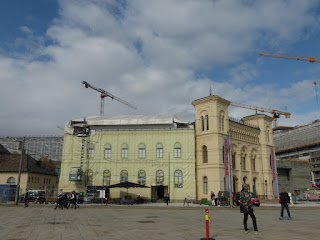We are now settled into the apartment and have started to establish a sort of routine, except that Charlie, under the bad influence of his mother, keeps later hours than Andrew. Andrew is ready to go for an early morning walk at 7:00 am or so but Charlie resists and prefers to venture out much later in the morning.
But he is a lovely boy.
He has a real regal air about him. Or long suffering? He is very affectionate and playful,
a pleasure to look after.
An attractive Oslo building in the neighbourhood.
These are rubbish receptacles, with the one on the right for recyling cardboard and paper products. There are locks on each so only residents of the building they serve can get access. The big truck comes along and lifts the whole container up and tips it into the truck. Quite fun to watch.
The Noble Peace Prize building. Under some sort of reconstruction, as is about half the city. Traffic is re-routed in many parts for this reason.
We are posing in the front.
The Historical Museum building which is obviously under renovation but open for business is covered in some sort of giant plastic wrapping with decoration of the building underneath.
There are various types of salami in the shops here. I don't mean Italian, Hungarian or Dutch but beef, reindeer, etc. The reindeer salami has quite a strong taste. Not a subtle, easy to miss flavour!
I have to say, the herrings in Scandinavia are a great disappointment. They are all in some sort sweetish brine (as are the anchovies). Hungarians. Poles and the Dutch eat proper pickled herrings in a vinegary solution much like pickled cucumbers. I spend all my time washing the various types of herrings I try, either to get rid of the sweet muck, or the salt. In Sweden we tried the various kinds of shrimp salads and they were delicious, unlike the herrings which were much the same as here in Norway.
The National Theatre.
Back of the National Theatre - still impressive like most buildings in Oslo. Solid and imposing.
Statue of Norway's most famous playwright, Henrik Ibsen (1828-1906). Ibsen qualified as a pharmacist's assistant before embarking on a more illustrious and longer career as a playwright. The Ibsen Museum which occupies his last home where he lived and is close to the Royal Palace is unfortunately closed for renovations until 2021. It is by all accounts a superb restoration very true to the period and style when it was last occupied for 11 years by the artist and his wife.
The King's Palace or King's Castle as it is known in Norway.
Parliament which is fronted by a big demonstration today against windmills.
A young Sami woman in traditional Sami costume.
Sami man wearing traditional Sami clothing.
The Sami (historically known as Lapps or Laplanders in English) are an indigenous Fino-Ugric people of northern Europe inhabiting Sapmi, which today encompasses parts of northern Sweden, Norway, Finland and the Murmansk Oblast of Russia.
Tonight's dinner, something I have been wanting to try, but found disappointing, Norwegian fish cakes from the supermarket. They look better than they taste. Not as bad as the herrings but not as good as Thai fish cakes you get back home. And the potato salad is a bit too creamy for my taste. But the smoked salmon we tasted from the left-over package in Jane and Ofer's fridge was to die for. I think that Norwegian smoked salmon is the best you can get. We intend to repeat this taste experience many more times while we are here.
Jane told us about Oslo's best kept secret, the Gronlands Torg Frukt og Gront (Gronland Fruit and Vegetable shop). Here, in the middle of the most expensive city in the world, including food prices, is a little haven of Turkish owned more reasonably priced and fresh, beautiful fruit and veggies. This is because the owners don't buy their supply from the big corporate mega farms like the regular supermarkets do but from smaller import companies. You mostly pay about half of what you would elsewhere in the city. It is always crowded so obviously many others are in on this secret.
Next to the fruit shop is a Fretex shop, one of the numerous Oslo branches.. Fretex is the largest second-hand chain store in Norway with a total of 50 stores all over the country. It is owned by the Salvation Army but it is like no Salvos shop as we Aussies know it. It is stylishly arranged, as most of Norwegian shops and products are, and unbelievably expensive. OK, probably not as expensive as new, but the naive Aussie shopper wandering in wanting to buy some bargains, forget it.


















No comments:
Post a Comment